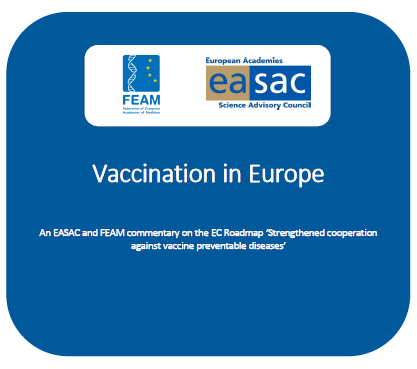Report by the World Health Organization
In this context, FEAM and EASAC have joined forces in addressing such an important and pressing health issue for Europe by developing a joint commentary on the EC Roadmap with a focus on vaccine coverage, vaccine hesitancy, vaccine availability and new vaccine development. Ten recommendations to improve vaccination in Europe are included:
- Investigate the reasons for low and decreasing vaccine uptake at the level of EU member states in order to develop tailor-made interventions. Make use of the WHO TIPS programme.
- Develop and implement a European vaccination card and registry. Do not give normalisation of vaccine programmes (choice dose and timing) among different countries a high priority.
- Recognize that not all vaccines in the vaccination programmes are of equal relevance for public health and individual protection. Make priorities within the programmes.
- Recognize that it is important to continue the commitment to invest in research and innovation to provide future generations of safe and efficacious vaccines. (see recommendations 9 and 10).
- To deal with the problem of vaccine rejection and hesitance, realise that the approach to vaccine hesitant, vaccine resistant, and vaccine rejecting groups is different. With the help of social scientists, develop strategies to enhance vaccine uptake in vaccine hesitant and vaccine resistant individuals.
- Develop a monitoring system for vaccine shortage and stimulate vaccine production by industry at the European level, with continuation of robust European frameworks for ensuring quality and safety of manufacturing.
- Reassess the issues for the BCG vaccination programmes in childhood: the vaccine does not induce long-lasting protection against tuberculosis, and there is a serious worldwide shortage of the vaccine.
- Investigate and optimise vaccination schedules for those vaccines for which there is a shortage.
- Develop a priority list of those vaccines that need improvement.
- Develop a priority list of vaccines for which there is high need.

